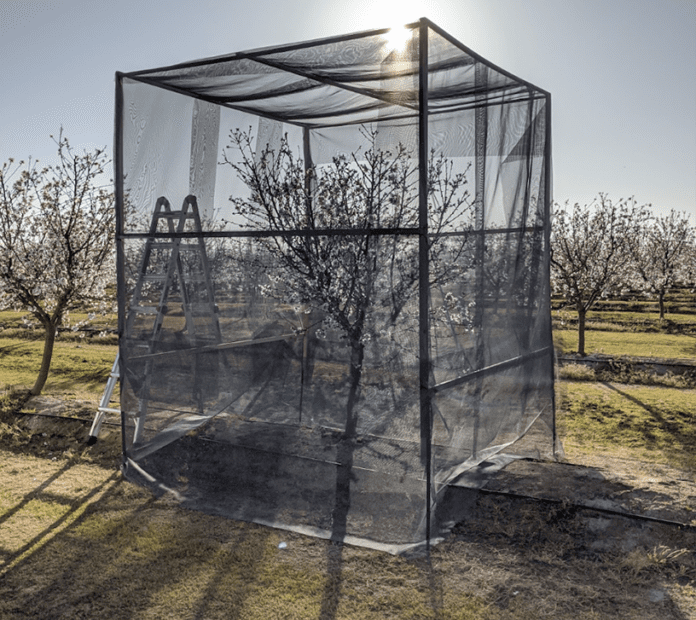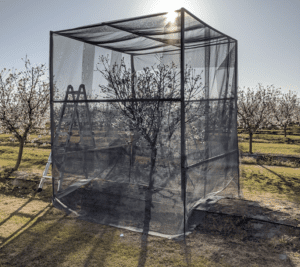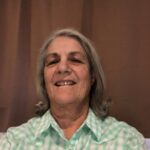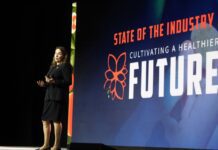
When self-fertile almond varieties were first introduced, one of the advantages listed was the savings in pollination costs. However, growers who planted self-fertile almonds soon found placing hives boosted yields, but guidance on how to pollinate these orchards in terms of hives per acre is limited.
Dr. Angelita De la Luz, global pollination expert with Beeflow Inc., collaborated with Dr. Elina Lastro from UC Davis agricultural extension services, Dr. Arathi Seshadri at the USDA-ARS Honeybee lab and Zac Ellis at Olam Food Ingredients on research to determine the optimal hive density for self-fertile orchards.
The name of a major self-fertile almond variety “Independence” was a nod to the tree’s ability to set a crop without cross-pollination, that is, requiring pollen from another variety, a potential production cost saving for growers. Pollination researchers, growers and consultants have come to understand a certain hive stocking rate can maximize yield potential in an orchard, and there may be crop quality advantages.
In the pre-print article, De la Luz noted in a self-compatible almond variety the minimum number of bee visits needed per flower for nut set is at least half of the bee visits needed per flower for nut set in cross pollinating almond varieties. Therefore, self-fertile varieties benefit from bee pollination but require fewer hives per acre.
Previous research by Beeflow shows honeybee pollination improves nut set and yields in Independence almonds. The current study dug a little deeper to determine the basis of the recommended stocking rate and the different factors that affect hive stocking rates in self-fertile orchards.

Self-fertile almond trees will set fruit with no managed honeybees present, but at a lower rate. A previous study cited in De la Luz’s research recommended honeybee pollination, demonstrating an almost 20% increase in kernel yield compared to bee-isolated trees. The results are replicated in a current study.
De la Luz noted several factors come into play when determining hive numbers in an orchard. A self-fertile orchard surrounded by other self-fertile orchards would need more hives per acre for pollination than a self-fertile orchard adjacent to self-incompatible almond varieties that depend on pollinators. Those orchards would have a higher number of hives, and the bees are likely to fly over to the self-fertile trees.
The first year of the research focused on the impact of pollination within a self-fertile orchard planted with Independence that was not stocked with honeybees (no hives per acre). In this study, some trees were also caged to prevent honeybee access while others were left open to allow for pollination. Both nut set and whole tree yields were higher for trees with pollinator access. Kernels from trees with honeybee access were 8% larger than kernels from trees with no pollinator access.
The second year of research was done across three orchards stocked from zero, one and two hives per acre. The research team found that stocking rate positively influenced the number of bee visits to open trees but with diminishing returns in terms of visits to flowers at higher stocking rates. Specifically, orchards with no hives had the lowest number of bee visits, but the orchards stocked at either one or two hives per acre had equivalent numbers of bee visits.
This research showed economic gains when the stocking rate was half to one hive per acre in self-compatible orchards with no economic gains at a higher stocking rate. However, the study noted as self-fertile orchards become more widely planted, they may no longer be adjacent to self-incompatible orchards, and continued benefit of bees flying over from orchards with higher hive stocking rates will likely decline.

Cecilia Parsons | Associate Editor
Cecilia Parsons has lived in the Central Valley community of Ducor since 1976, covering agriculture for numerous agricultural publications over the years. She has found and nurtured many wonderful and helpful contacts in the ag community, including the UCCE advisors, allowing for news coverage that focuses on the basics of food production.
She is always on the search for new ag topics that can help growers and processors in the San Joaquin Valley improve their bottom line.
In her free time, Cecilia rides her horse, Holly in ranch versatility shows and raises registered Shetland sheep which she exhibits at county and state fairs during the summer.















